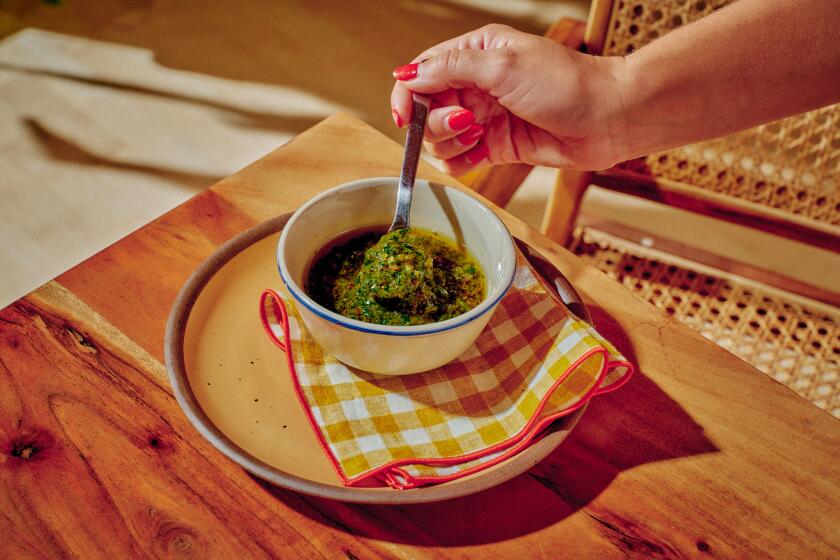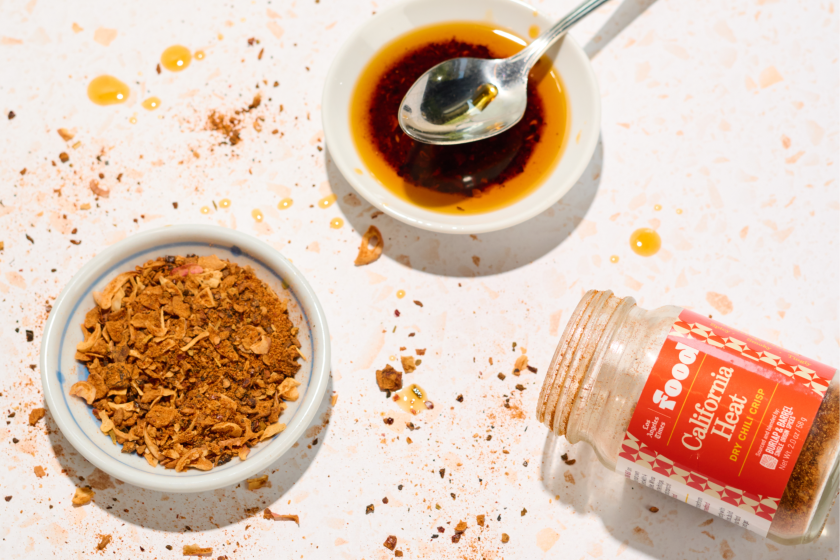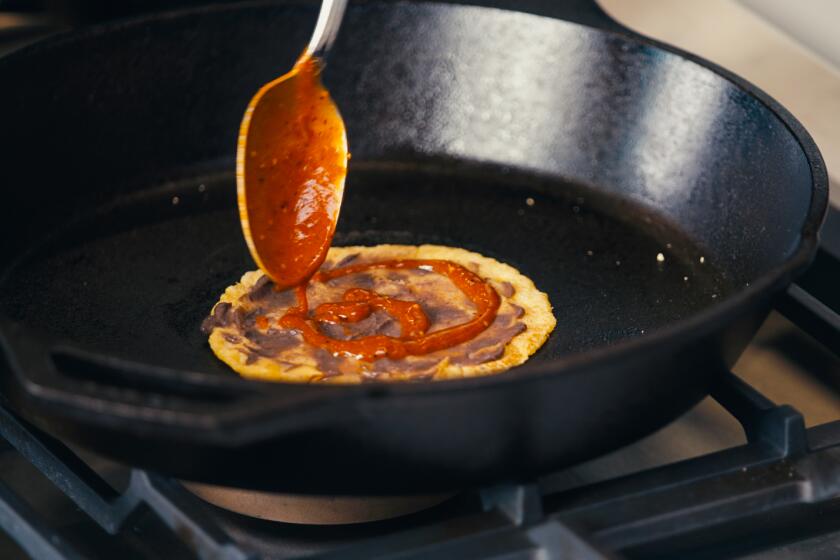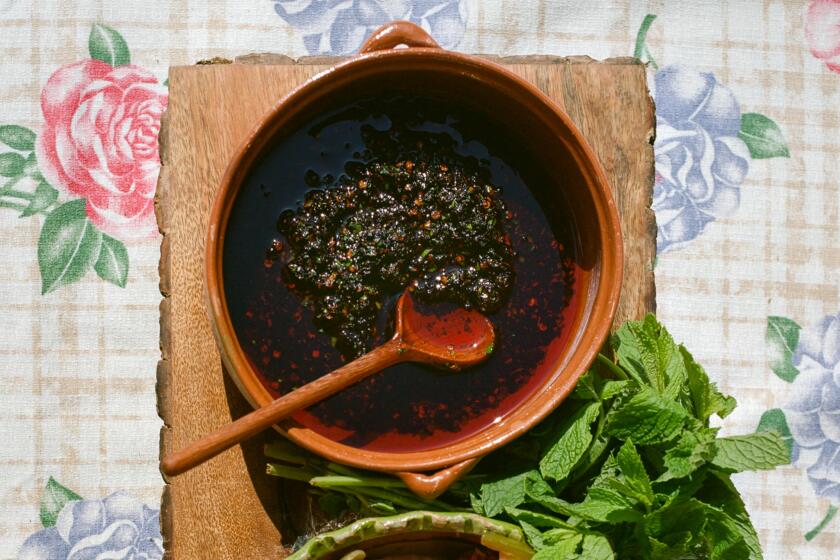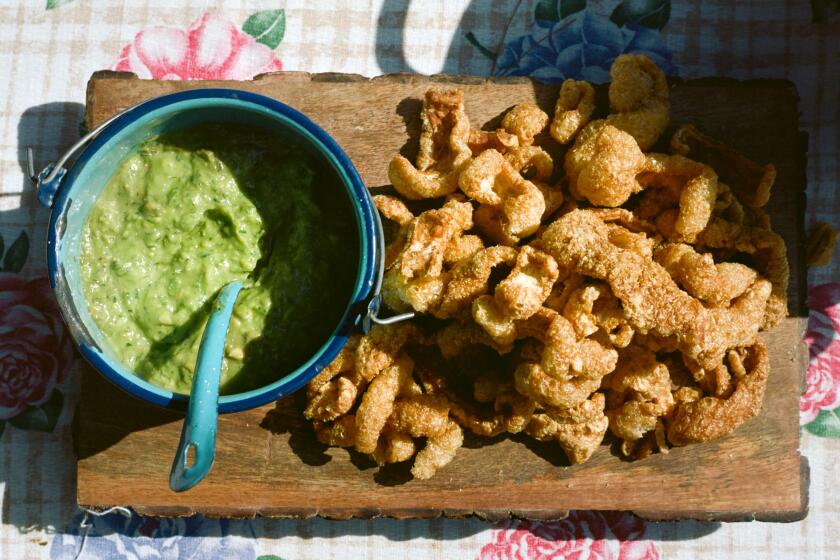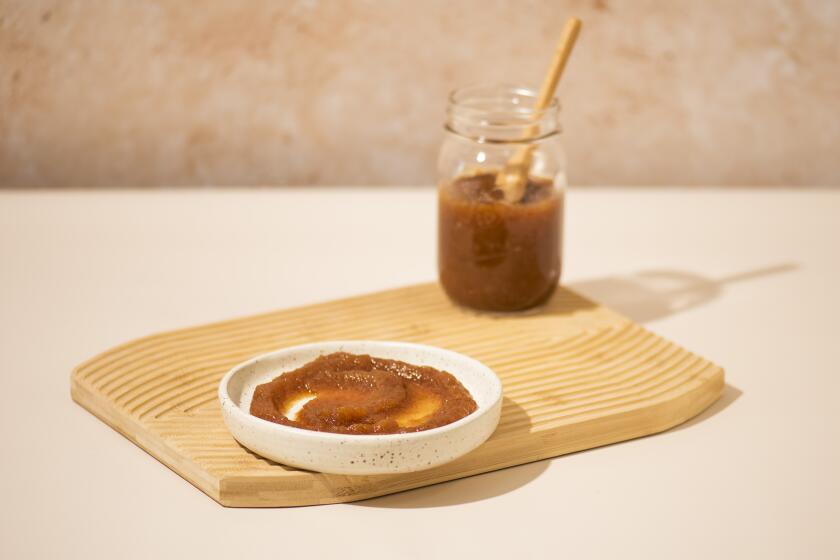Red chile sauce

- Share via
My family was convinced that we made the best enchiladas around. You might consider this attitude to be insufferable until you tasted them. My mother and grandmother, great cooks only a little prone to exaggeration, swore that the enchilada recipe had not been changed in 150 years.
How could anyone really know since the recipe was only given by word of mouth to make sure that no one outside the family could steal it? I changed all of that when I wrote down the recipe’s twists and turns.
When you read it, this recipe for red enchiladas may seem straightforward and not at all unusual. But wait. There is something serendipitous about combining the heat of the red chile, the sweetness of the long sauteed onions and the sharp saltiness of the cheese.
Meat was never added to this filling. Some rancho families added chopped hard-boiled eggs, but we did not. When Uncle William married an Irish girl called Margaret, she offered to bring enchiladas to a barbecue. She added fried hamburger and was never asked to bring enchiladas again. She used her Irishness as an excuse for the lapse. Margaret is now 87 and still adding hamburger to her red enchiladas.
It is next to unthinkable for there to be an important occasion--whether it is a christening, wedding, birthday or funeral--without red enchiladas. Our son, Ian, requested them to celebrate his graduation from UCLA. When Uncle Jack, the next-to-last rancho uncle, passed away, the biggest topic of conversation at the funeral was that there weren’t any red enchiladas. The younger generation had omitted them for convenience.
Like many foods that lie deep within the culinary memory of California, the red enchilada is a fusion food. Neither Mexican nor Spanish, it is Californian.
The Spanish subjects and soldiers who laid claim to Alta California had already become enamored with many of Mexico’s foods, a particular favorite being red chile. The natural thing to do was to blend what they brought from Europe with what they found in Mexico. They used red chile as if they had been born eating it. It coated meats and enriched sauces. It is said that the early Spaniards in the Southwest ate even more chile than the Mexicans who had introduced them to it.
The native populations in all the regions of Mexico used minuscule amounts of fat before the arrival of the Spaniards, who introduced the wonders of adding flavor with lard and olive oil. Pre-Spanish enchiladas were practically fat-free, later enchiladas used frying gloriously. Frying the red chile sauce cuts the raw, sharp flavor of the pure chile, smoothing it out. Sauteing the onions makes them sweet and almost caramelized.
Every family recipe has its secrets, and this one is no different. At one time there was great argument as to the type of red chiles used and how they had been dried. I consider that settled. Sun-dried chiles are preferred. Artificially dried chiles can be bitter.
That doesn’t mean that all new things are bad. For years I have been soaking dried chiles before pureeing and straining them, just as my grandmother taught me. Then one day, as I was looking at the dark red soaking water, I had a chile epiphany. I decided to try steaming the dried chiles instead, and I found this produces the most flavorful sauce. Long soaking saps the flavor of the chiles just as it does with frijoles .
The type of tortilla is equally important. For my ranchero family, there is only the hand-rolled and hand-stretched flour tortilla, made so thin you can read the newspaper through it. If the flour tortilla is supple, it doesn’t have to be heated or fried. It can be dipped and coated with red chile sauce and then filled.
Enchiladas made with thin flour tortillas puff more, but I also love enchiladas made with earthy corn tortillas. If you prefer corn tortillas, it is best to use day-old ones and fry them in a few teaspoons of light olive or canola oil. They need to be heated, not only to soften them, but also because it helps to seal the surface, which keeps them from disintegrating when sauced.
The enchilada has traveled far--thousands of miles and hundreds of years--taking on different qualities depending upon where it made landfall. In California, it became our very own red enchilada, ultimately symbolizing the fusion of Mexico and Spanish California.
Now old Red has transformed itself into new versions, such as the Seafood Enchiladas and the Black Bean and Vegetable Torta. Just like a family or its legends, every generation adds something new.
Hold the California and ancho chiles under running water to rinse. Use scissors to cut off the chiles stems and cut the chiles in half. Shake out the seeds onto a paper towel. (Put the seeds in your garden for the birds.) Place the chiles and garlic in the top half of a steamer set over simmering water. Steam for 25 minutes. This technique, as opposed to soaking dried chiles in boiling water, preserves more of the chile flavor.
Remove the chiles from the heat. Place 1/3 of the chiles in a blender with 1 cup of water. Puree until smooth. Pour the puree into a wire strainer nested over a large bowl. Continue pureeing the rest of the chiles, garlic and water as in the previous step, in batches, so that each time you add 1/3 of the chiles. Push all of the chile puree through the strainer using a spatula or wooden spoon. Be sure to scrape off the chile puree clinging to the bottom of the strainer. Pour the remaining water into the blender and turn it on to help clean the blades. Pour this chile water through the strainer to catch the last bit of goodness. You should now have about 3 1/2 cups chile puree.
Heat the olive oil in a deep skillet over medium heat and add the flour, toasting lightly until light nut brown, stirring, 4 to 5 minutes. Whisk in the chile puree and add the oregano, vinegar and salt. Simmer the sauce for 20 minutes to blend flavors. Taste, and if the sauce seems a bit sharp, add sugar. If the sauce seems thick, add water or broth, simmering again for about 5 minutes.
Get our Cooking newsletter.
Your roundup of inspiring recipes and kitchen tricks.
You may occasionally receive promotional content from the Los Angeles Times.










